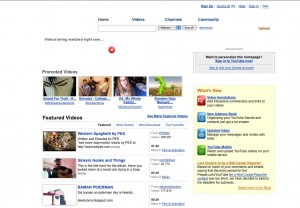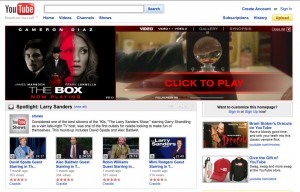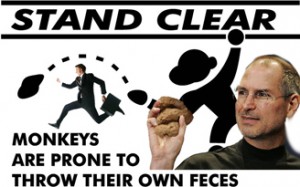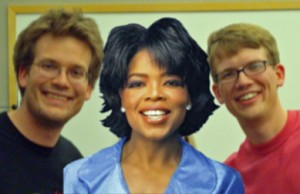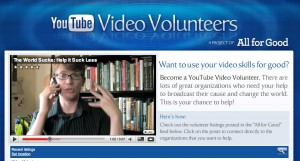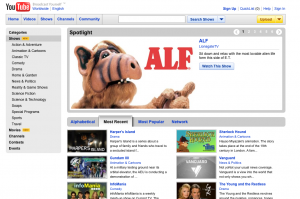I wrote about Jessica Kurson recently, and yesterday spent the afternoon with the nationally-known Comedian in NY City (Times Square). I don’t think I’ve had this much fun making a video in ages, and I’m certain this was my finest hour in NYC ever. Subscribe to her here.
Tag Archives: television
Can The Mutant-Child of Cable & Web Video Survive? Seven Magic Tricks.
Television networks have had no more luck spawning, popularizing, or learning from online-video content than newspapers have had increasing circulation in recent years. But Fox 15 Gig has caught some online-video gurus’ attention, and UncleNalts has 7 magic tricks for you television and cable mavens who dare enter the shark-infested viral online-video watery… thing.
The people have chosen. We are magnetically polarized to opposite ends of the content-duration spectrum: short-form content by amateur solo-acts or a lucky few over-produced television series. The mutated child of this man-beast marriage is not socializing well at school. But I’m here to help.
Seems Daisy Whitney (in this week’s New Media Minute) thinks Fox’s 15 Gigs (which launched quietly in the summer) has a fighting chance. Watch her video to find out why. Or trust me for a summary. Or just shut-up and watch last week’s episode because she had a totally hawt guest).
- She digs Black20, the creators of “Easter Bunny Hates You” (which I shamelessly plagiarized in my Mad Turkey, but resisted rerunning this season).
- She believes 15 Gigs is “learning from the mistakes” and has an advantage of not being a first-mover like ABC and HBO’s failed attempts.
- Most importantly, she likes the concept of testing low-cost production online (sometimes less expensive than a script) before investing in television.
- She loves violet her French poodle Violet and is uncomfortable with its photo so close to that shark.
Adam Right of TubeFilter.tv has some additional positive thoughts on 15 Giga (the studio was named, perhaps, with either homage or dis to the phrase “15 minutes of fame”). 15 Giga is spawned from Fox’s cable production arm, Fox Television Studios, which is best known for The Shield and Burn Notice (which I purchased in its entirety on iTunes). Adam Right, like Whitney and her poodle, sees this as a “different approach to creating a new media branch with 15 Gigs.” The difference, says Adam, is:
- going edgier than television (see puppets using cocaine and smoking)
- giving producers room
- looking at ways to leverage interactivity of web
- focusing on moving web series to television (which seems somewhat in conflict to point one)
- keeping production costs down ($5-$20K per series)
Thank you, Daisy and Adam. You’ve tasted the Kool-aid and I’ll watch to see if you die before I have a sip. Now it’s UncleNalts’ turn… Web series aren’t working yet. Maybe 15 Gigs will crack the code, but it’s a dry market, girlfriend. Do you mind if I call you that? It doesn’t sound gay does it?
 As I’ve said: In something that’s perhaps counter intuitive, people magnetically shift to opposite ends of the content-duration spectrum. The hybrid mutation is neither as satisfying as a 30-60 minute show or as personalized as a virtual-BFF (best friend forever) on YouTube. (Man I should get paid to blog… this is poetry). I loved The Guild but I forget about it during gaps… and for reasons I can’t explain I haven’t caught up. I watch maybe 6-12 shows television shows weekly and countless online-videos… but almost no web series. You can’t argue that they’re not part of our media-consumption habit yet (but in the tips below, I’ll tell you when that will change… so stay alert despite the snow falling over my words).
As I’ve said: In something that’s perhaps counter intuitive, people magnetically shift to opposite ends of the content-duration spectrum. The hybrid mutation is neither as satisfying as a 30-60 minute show or as personalized as a virtual-BFF (best friend forever) on YouTube. (Man I should get paid to blog… this is poetry). I loved The Guild but I forget about it during gaps… and for reasons I can’t explain I haven’t caught up. I watch maybe 6-12 shows television shows weekly and countless online-videos… but almost no web series. You can’t argue that they’re not part of our media-consumption habit yet (but in the tips below, I’ll tell you when that will change… so stay alert despite the snow falling over my words).
So here’s some free advice — step right up and taste the magic potion — for those cable/network peeps brave enough to dare to tap into serialized web shows. These magical seven tips will help you with your mutant content or your money back the next time I pass through Passamaquati.
- Speed up your editing cadence to border-line mania. Those music-laden dramatic television transitions and rack focuses of NYC cabs are begging the audience to ditch when they’re “leaning forward” watching web content. Think Fawlty Towers, Basil-like speed. Take a 10 minute script and force it into 5 minutes. Then the pregnant pauses will have ball-busting impact. The first 10 seconds must grab them, and suck them in. Hold onto their attention like they’re an over-caffeinated Chihuahua with ADHD. Because we, I mean “they,” are.
- Hedge your bets and hyper-niche. Go for volume… lots of shows so many can fail. Fail, fail, fail. I’ve done it 800 times. A few stuck. More importantly, instead of marketing them widely appeal to audiences, focus on really niche audiences who will share them. For instance, a well-produced show about a restaurant staff will probably travel among those who are working (or have worked) at a restaurant… Go super narrow. You’ll need a rabid inner circle of fans to survive the next tip.
- BFF the ardent fans. Web series simply lack the personal interaction that is felt when someone watches a favorite vlogger talk to them, pull a stunt or even do a skit. The characters in web series often talk at each other, and forget me. Hey- I’m watching… are you an actor or a real person? So please add some interactivity via technology, but more importantly break the wall down between the actors and the hardcore fans. No I’m not talking about a f’ing scripted character Twitter profile. I’m not talking about interactive “chose your own adventure.” I’m talking about the actual actors (sorry- not the writers) engaging with the fans directly in comments. I promise you this: one personal touch between a creator/actor and a single audience member and you’ve got a loyal fan who will tell 21.2-52.7 people about the show. I promise.
 Suffer through Routinely Popular Online-Video Personalities or YouTube Partners. I know it makes you insane to see amateurs gain huge audiences for videos that are significantly worse than yours. But endure it and learn from it. Watch the most popular people and daily videos and rather than groan, ask “what is this clown doing that we can replicate.” Be selective about what you mimic, of course, because most of my crap has no business on television. But a lot can be learned from watching what’s gathering a crowd today. Don’t get distracted by one-hit wonders… watch the people that keep an active fan base over time.
Suffer through Routinely Popular Online-Video Personalities or YouTube Partners. I know it makes you insane to see amateurs gain huge audiences for videos that are significantly worse than yours. But endure it and learn from it. Watch the most popular people and daily videos and rather than groan, ask “what is this clown doing that we can replicate.” Be selective about what you mimic, of course, because most of my crap has no business on television. But a lot can be learned from watching what’s gathering a crowd today. Don’t get distracted by one-hit wonders… watch the people that keep an active fan base over time.- Collaborate. Get the characters of a web series into other popular shows (and give prominent web personalities cameos). That’s how YouTube stars are discovered, and it’s how many classic television shows were spawned. iChannel did this with me, and The Retarded Policeman exploded when it started giving cameos to the most-subscribed talent on YouTube. I want to see someone from Glee show up in The Office… I’ll get chills.
- Drink Your Prune Juice. You’ve got to be regular. I’ve fallen recently on YouTube because I’m not posting videos as frequently. People gravitate toward content that has daily uploads… they build it into their day. If you can be predictable as posting at a specific hour, it’s even better. Remember when we’d all wait for ZeFrank to post? Yeah neither do I. Sorry but a week is simply too long for web series… daily is ideal and not more than 2 days.
- Persist. This is going to get a whole lot easier when we can conveniently stream web content from our televisions, and that’s happening as we speak. I believe this transition will remove the biggest barrier to serialized web content — because we have fundamentally different expectations of storytelling in various mediums. Soon our nightly ritual might be trading 30 minutes of television-viewing for 5 niche mini-shows. And if the people and stories of each episode cross over into another show… that’s drama, friends.
Now go print this out on your Ink Jet, and Scotch tape it to your wall or someone else’s. Because we both know that everything that happens to you in the next 6 months will make you forget this list.
YouTube’s “Yahoo-Like” Homepage Makeover: More Ads, Professional Content
I’ve often said that you need to logout of your account to see what YouTube really looks like, since that’s what the majority of viewers are seeing. Let’s look at one of last year’s last Archive.org homepage screen shots of YouTube, and compare it to today’s.
Some differences:
- 2008 has lots of white space and simplicity like Google. Today’s homepage features a film ad that dominates almost the entire “above the fold” region.
- The content featured on 2008’s page is mostly consumer-generated or amateur. Today it’s Crackle content and yesterday was FunnyorDie.
- Last year’s page featured new functionality. Today’s features a “house-ad” for YouTube/Google’s store (watch out for those Lava lamps… they sometimes forget the logo).
- The featured videos, like on Break.com, were new each day and remained constant. Today we see a variety of videos rotating, and many are popular amateur videos (mixed with some advertised content). We’ve shifted from homepage featuring to “mini-featuring” via “spotlight tagging.”
- The biggest change is not evident on the homepage. Now the power-engine behind YouTube views is “related videos,” which can account for a significant portion of views.
Again, YouTube is behaving less like parent Google and more like Yahoo.com or a media company. Perhaps the price it can fetch for a homepage takeover is too tempting to resist. It’s a great way to get a film “top of mind” awareness to jump-start a weekend box offices, or a television debut (and I was especially impressed with V’s custom YouTube ad unit). And who can fault YouTube, which bears the bandwidth cost of so much unprofitable consumer-generated content to lure mainstream users with semi or pro content that can be better monetized?
Still, it’s remarkable what a difference a year can make. From where I sit, the biggest flaw in the user-interface is that it’s not entire inviting to visit the most-popular or genre-specific videos. One tends to use the homepage as a search engine, or be drawn to whatever thumbnail or title that happens to appear below the ad-du-jour.
I’ve suggested before that the day of the YouTube editor is behind us, because the sub-page featured videos don’t seem to garner significant views. However I’d suspect “spotlight” videos are driven not just by algorithms (most-viewed, longest average viewer duration, highest rated, related) but by editor preferences. If I’m right, the editors still have an active hand in deciding what YouTube amateurs find audiences. Interestingly we tend to see a few dozen of the same Partners with the most active rotation, which suggests editorial favor-ability or content favored by “crowdsourcing” as defined by the engineers.
AppleTV & iTunes Dissintermediates Cable? Bigger Than Balloonboy Story.
Wowzer. Your’e going to want to read this post, because it’s hot news. And because I put some effort into some seriously solid metaphors that damned well better be scraped by some bigger bloggers.
For years I’ve been bitching and moaning about Apple not putting its little heart into AppleTV (instead of screwing with these ridiculous iPhone toys and their petulant little “apps”).
And all the while, the little Steve Jobs may have his eye on dissintermediating cable television. Fast Company provides some saucy news, and sources “All Things Digital.”
But this isn’t about the AppleTV, idiot. No it’s not about software or hardware. Apple is basically envisioning a $30-per-month iTunes television offering, which would give networks new reach via 100 million iTunes users. And that means you, like the 100 million iTunes users, would start watching shows via Apple both on your computer and (via some box) that big-ass monitor you call a Plasma or HDTV.
Do I need to repeat that? Television shows when you want, and on whatever damned screen you want. Oh, and a gentle reminder that technology companies will control your fate more than telephone, cable, publishers and networks (never mind that whole AOL/Times Warner hickup).
Alas, it’s hard for me to envision a scenario where cable companies don’t start tossing fecal matter like angry apes. But it’s a game of chess, not the beloved “toss-the-feces” we’d play at birthday parties. If Disney, as an example, slept with Apple… what could the angry ex (cable companies) do? They can’t very well drop Disney. And since Disney’s move would be the “tipping point” this all needs, Disney gets to set the terms. Girl, you know those Mickey Mice could nibble up an Apple like Piranha to a cow.
Fundamentally the broadcast networks have to decide whose bitch they want to be. Cable television or Apple’s.
If the music industry feels that iTunes was a good thing (additive revenue that didn’t exactly kill radio or CD sales entirely), then maybe the television networks go the same route. And to keep Apple “in check” they can replicate the terms via Hulu, YouTube or even some genius that manages to build a television-manufacturer standard.
The bottom line, however, is the train already left the station. I’m an example of a fast-follower (not early adopter), and I’m spending more each month on $1.99 television episodes than I am on a cable bill! I loath Verizon’s interface and on-demand library, and persist only because my wife likes depressing news and Nancy Grace, and my kids need their Nick Jr.
To be fair, I’m discovering I liked the control of “lean forward,” but I want to lay down on the couch and bed too. Love my TiVo, but it didn’t catch any fresh fish (like during this damned Fox Fringe hiatus), I dive into AppleTV and try out a new show… maybe buy a few episodes or a season pilot because $1.99 ain’t a bad price for 45 minutes of some boob-tube love making. I’m less often surfing YouTube’s most-popular list because it’s just a sad reminder remind of how much better Sxephil, Shaycarl, CharlesTrippy and ShaneDawson are than me. Last night me, Charlie and Grant and me did start a YouTube binge that began with Edbassmaster, then progress on a downward spiral that culminated in farts and babies. But then we jumped back to paid episodes of Angry Beavers. Damn that intro is hip.
Speaking of YouTube, those trained monkeys better get their own poop in palm. They’ve cornered the market on searchable video, but this is a bidneth model that can move faster than ad-supported web video. I think this crap (you know the kids are saying that now like it means nothing anymore) is bigger than the Balloonboy story. Except the Falcon hiding in the attic and puking on CNN might just be… Comcast, Verizon and other cable providers. I predict Hulu maintains its relevance if this shakes out, unless Apple iTunes makes itself incredibly easy to purchase and view via both web and those BIG ASS televisiony-like monitors. Hell in a few years, maybe we don’t even know or care where our video content comes from.
Yeah- I even think this story might be bigger news even than last night’s AppleTV upgrade:
“WTF? A vertical menu?” he says, tossing his mini white remote that has been chewed to near obsolescence. Fade to black.
Oprah: Get Hank and John on TV to Show the REAL YouTube
You know who you should have on your show, Oprah? Hank and John of Vlogbrothers, who became popular when they communicated for a year strictly through alternating “video blogs” (vlogs).
Here’s the pitch, Oprah producer (or someone who knows them and will forward this on). The two guys have a loyal following of “Nerdfighters” who use online-video to reduce world suck. They’re smart, talented, and nice guys… and are helping promote a new YouTube volunteer program. Their fans proudly wear the Nerdfighter badge, and rally the community in funny and life-enhancing ways. It’s not cats and skateboards. But it’s indicative of the power of social media (and video, its most visceral form) to influence masses… in positive ways.
If I was promoting an important cause, I can think of no greater honor online than having John and Hank lend their influential voice.
In fact the only thing they’re not good at promoting is themselves… because it’s not ABOUT Hank or John. It’s about improving the world.
And that’s why I’m pitching you for them, dear Oprah. I would like to be in the green room as they prepare to enter the stage. Because I’ll totally moon one of them before they join you on TV to help improve the world.
P.S. If you’re a nerd fighter, join the cause! Get Hank and John on Oprah, where they can maximize their reach beyond the inner YouTube community!
Nalts in the News
YouTube Goes Hulu. Web Stars Promote Lionsgate.
YouTube has launched its answer to Hulu. Fred is doomed. Alf is back. The new sections are “shows” and “movies,” and involve content from Sony, CBS, Metro-Goldwyn-Mayer, BBC, and independent film studio Lions Gate Entertainment.
In perhaps an effort to soften the blow to amateurs, YouTube & Lionsgate hired well-known YouTube weblebrities including LisaNova and DaveDays to promote Lions Gate’s recent Crank movie.
DaveDay’s video is MIA. Here’s Xgobobeanx’s contribution, and ShayCarl‘s.
YouTube amateurs and professionals playing together like dogs and cats? What next? Fred promotes Alf?
It’s worth noting that the combination of the YouTube star power yielded more views (nearly 1 million) than an average homepage ad unit.
NBC Brings Advertisers & Creators Together “From Start” for Web Series: Everything New is Old Again
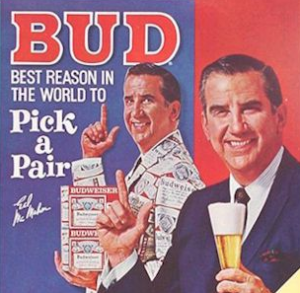 TubeFilter, which tracks the “best scripted web series,” reports that NBC Universal Digital Studio will create a slate of new original web series to be produced with 60 Frames Entertainment.
TubeFilter, which tracks the “best scripted web series,” reports that NBC Universal Digital Studio will create a slate of new original web series to be produced with 60 Frames Entertainment.
NBC promises to bring the “most talented writers and producers in entertainment” in efforts to “create a much higher-quality production value than what is normally associated with digital production.” The Studio’s “innovative new business model” will bring advertisers and content producers together “from the start.”
This is significant news, folks, for two reasons. First, it’s signs that NBC continues to be the leading network for online evolution. Second, it’s a novel approach for online-video, but based on a model that has proven itself over time.
It won’t be pain free, but could change online video in meaningful ways. If NBC’s muscle can keep creators and advertisers in a room and force them to cooperate, then we may see something far more interesting than Hulu shows with interstitial forced ads. Products woven into plotlines, product placement… it’s not new, folks.
- Jack Paar, who hosted the Tonight Show before Johnny Carson, once described a sponsor’s underwear as “fitting so tight, it’s like being hugged by a midget.” The sponsor dropped.
- P&G created the Soap Opera to reach stay-at-home moms.
- Survivor’s “product integration” with brands like Target brought he show an additional $12 million per sponsor.
- Product placement dominates films- Jodie Foster recently showed us how obnoxious this could get with Progresso and Purell dominating “Nim’s Island” screen time and dialogue.
- Even Lonelygirl15 had a character that worked at Neutrogena, which wasn’t coincidental.
As much as a like product integration, I just want to be the next Ed McMahon. Anyone keeping a list of the products he’s pimped?
Is Online-Video Recession Proof?
 Online-video advertising is still dwarfed by television advertising. But fear not the recession, online video advocates! Fear not these gloomy photos of the depression that you’re seeing on all of the weekly magazines. And this is according to Christine Beardsell from Digitas writes in a ClickZ article.
Online-video advertising is still dwarfed by television advertising. But fear not the recession, online video advocates! Fear not these gloomy photos of the depression that you’re seeing on all of the weekly magazines. And this is according to Christine Beardsell from Digitas writes in a ClickZ article.
Here are three reasons Beardsell says online video advertising will come out ahead during an economic downturn. Parenthetically, search “recession” on Google Trends to see how freaked people are getting.
- No Longer Experimental. Past economic crises often led CMOs to cut back on experimental advertising, and they rely on the skills and responsibilities they’ve traditionally relied upon… as Keith Bobier, senior director of marketing at Unilever, put it: “We are not pulling in the reigns at all…there is nothing experimental about this for us.” In fact, during financial struggles, aren’t the customer-centric things exactly what brands and their customers need most?
- Possible, Affordable Optimization: If you’re a marketing executive given the option to either make two new TV spots for the year… or create several video brand content experiences throughout the year that can guarantee measurable, detailed, optimized results and build engagement with your customer, which option would you choose? You get less for more when it comes to TV spots.
- Less Buying, More Conversation: While there may be a lot less money to spend when money is tight, that doesn’t necessarily mean people will spend less time engaging with your brand. In fact, frugal spending often means longer hours researching products and discussing those products with trusted friends and family. And with research and conversations now happening predominately online, brands more than ever have the opportunity to join these discussions and help customers make smart purchasing decisions.
I’d add two things. When I tighten my marketing budget, I tend to focus on squeezing down the largest spend, and not starve innovation. So as long as online-video ads provide metrics (see Daisy Whitney’s article on TubeMogul and Visible Measures) then they’re not going to be the first part of the mix that’s cut.
What Did YOU Think of the Bill Gates & Seinfeld Campaign?
I MUST know what you think of this Bill Gates and Seinfeld campaign. Please scan this short article on the Huffington Post, and watch the clips if you haven’t. Then comment below, but be specific. Why do you like or not like them?
Then, and only then, are you allowed to peek at the “more” section where I offer my opinion.
Continue reading What Did YOU Think of the Bill Gates & Seinfeld Campaign?



